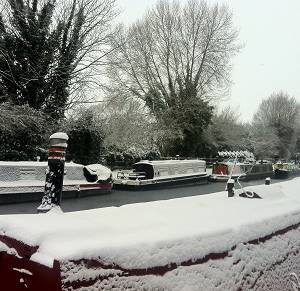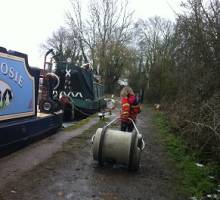
5 Top Tips for Surviving When the #Canal Freezes
Because the canals and waterways are generally very slow flowing they freeze easily at this time of year. For anyone living aboard this means that the water in the domestic water tank may freeze, and even the pipes at the local supply tap may freeze. Bearing that in mind it’s best to keep an eye on the weather forecast at this time of year and get some essential boat chores done in advance of the big freeze.
1) Empty the Toilet
For anyone that thought living aboard was all roses and castles I’ll start off with this most lovely of chores! If you have a cassette toilet you may be able to empty the cassette on foot or by car at your nearest Elsan disposal point, but if you have a pump out toilet then you may have a problem (i.e a full toilet) when the boat is iced in. You could therefore consider investing in a spare cassette toilet or ‘Porta Potty’ for those times of need.
2) Top Up the Water Supply
Some residential marinas have below ground taps, protected from the cold but I have lived on a CRT towpath ‘winter mooring’ and found the local tap to be above ground, frozen and in operable. It can sometimes be thawed with a boiling kettle – and sometimes not, as you’ll see in this three minute video I made one winter: The Snow Day.
If your local tap does work you may need to transport water using a large water carrier. An Aquaroll portable water carrier is brilliant for this because it rolls along the ground. Even my children are able to pullor push it along. It has a removable handle and can be stored on the roof of the boat when not in use.
3) Stock Up On Fuel
Remember if you’re living aboard and the canal surface is frozen solid the coal boat may not be able to travel and deliver to your area when you run out of fuel. In this case if you are running low on coal and wood you’ll need access to a car – and possibly a wheel barrow to carry fuel down the towpath. If you have a solid fuel stove remember to regularly sweep the flue. Check that your stove rope is sealing the stove door nicely. The Morso Squirrel stove is popular with liveaboard boaters.
4) Turn up the Heat!
The main heating is usually a solid fuel stove or a diesel stove, although there are various radiator heating systems available too. Many boaters I know will swear that an Eco-Fan will really improve the circulation of heat around the boat. An Eco-Fan is a heat-powered fan that sits on top of the solid fuel stove in the cabin. It increases the circulation of warm air around the boat and requires no batteries or extra power cords, but generates its own electricity: Therefore it’s silent and free to run!
5) Watch Out For Ice
If you need to go on an essential winter cruise – to empty your sewage tank or refill your water, then beware of icy surfaces. Locks can be particularly treacherous and ice can seem invisible. Falling in to the water near a spinning propeller can cause horrific injuries and I have also heard the ‘towpath telegraph’ tales of fatalities related to falling into icy water. You will also need to be aware that too much ice breaking can damage your hull, so it’s advisable to keep cruising to a minimum when the canal is frozen. Also, winter cruising plans can be waylaid by stoppages for maintenance works. Read more Boatshed tips on winter boating here.
Plan Ahead
So, if cold weather is forecast and ice is predicted, empty your toilet, fill up your water tank, stock up on extra coal, seasoned wood, kindling, firelighters and diesel. You may also like to stock up on supplies of tinned food, coffee, tea, beer and wine – or whatever else you consider to be essential!
Then simply relax by the fire.
Peggy Melmoth
Image credit: Narrowboat Wife
600,000 registered boat buyers
Sell your boat twice as fast
150,000 unique visitors per month
1000+ boats sold per year
50+ Boatshed branches world-wide
You may also like:
Living on a Boat: The Boatshed Guide (free) / How to Sell a Boat: The Ultimate Guide (free eBook) / How to Buy a Boat: The Ultimate Guide / Our Top 5 Articles From 2014 / Don’t miss:The Boatshed Grand Union Daily/ More articles.
New here? Come and say 'hello' on Facebook or Twitter :-)
Never miss an article: Sign up and get the latest blog articles sent directly to you, plus instantly receive our free eBook: How to Sell a Boat: The Ultimate Guide.


